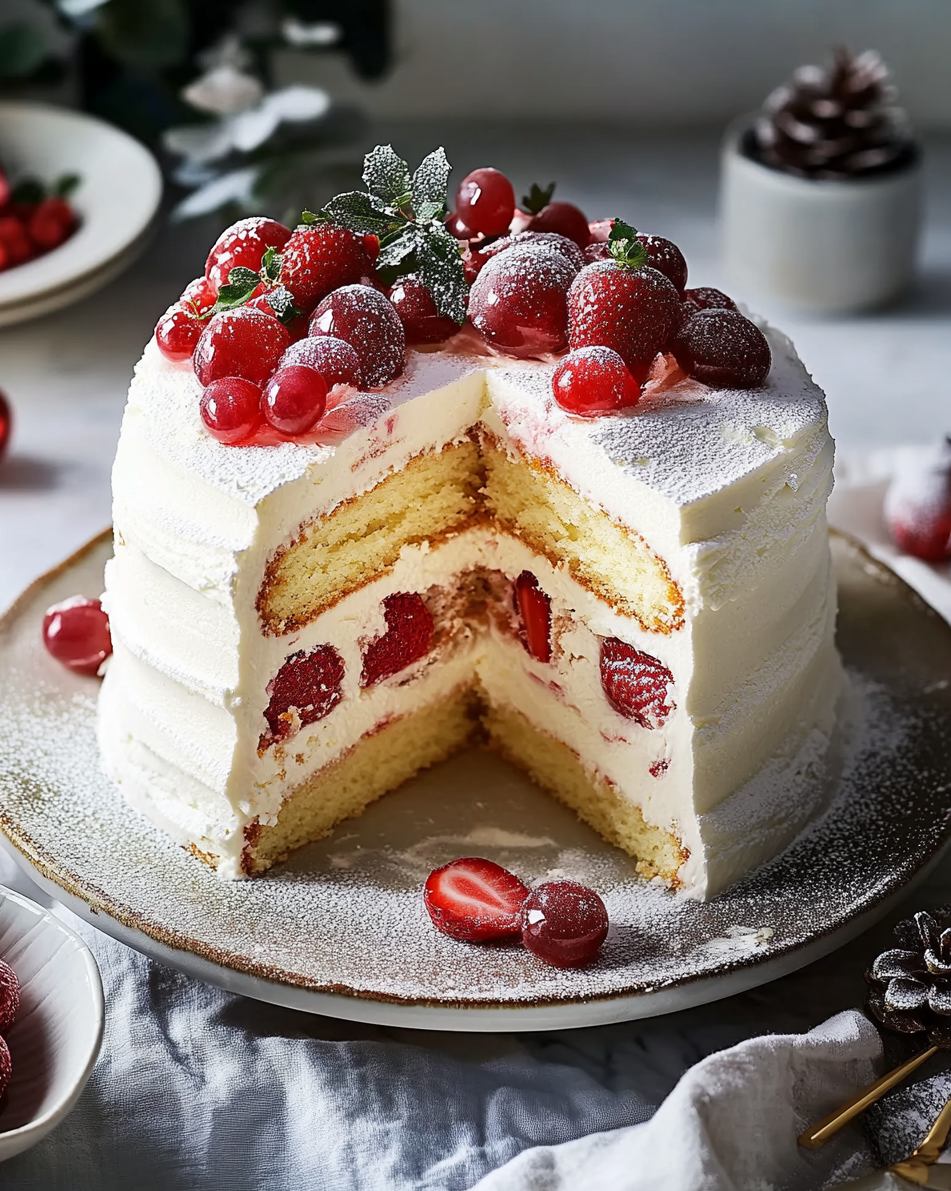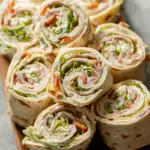The Japanese Christmas Cake, with its light and airy sponge layers, complemented by fresh strawberries and smooth whipped cream, is a true holiday delight. This cake is not overly sweet, making it a perfect treat for those who prefer a balanced dessert. Each bite is a mix of fluffy texture, the mild tartness of the strawberries, and the creamy richness of the whipped topping.
Traditionally served during Christmas in Japan, this cake brings festive joy to any gathering. The delicate presentation, with vibrant strawberries contrasting against the white cream, makes it not just a delicious dessert but also a beautiful centerpiece for your holiday table. It’s an easy yet impressive dessert that will wow your guests.
Full Recipe:
- 5 large eggs, separated
- 16 tablespoons white sugar, divided
- 1/8 teaspoon salt
- 1/2 cup all-purpose flour
- 2 tablespoons vegetable oil
- 2 tablespoons whole milk
- 1/2 teaspoon vanilla extract
- 1 pound fresh strawberries, hulled and sliced
- 1 1/2 cups heavy whipping cream
- 1/4 cup powdered sugar
- 1 tablespoon liqueur (optional)
- 2 tablespoons hot water
Directions:
- Preheat oven to 320°F (160°C). Lightly grease an 8-inch cake pan and line with parchment paper, extending above the pan’s edge.
- In a large bowl, beat egg yolks with 10 tablespoons sugar until pale and thick.
- In a separate bowl, beat egg whites with 6 tablespoons sugar until medium-stiff peaks form.
- Fold one-third of the egg whites into the yolks, followed by the remaining whites, gently folding to maintain airiness.
- Sift flour and salt into the mixture in two parts, folding until just combined.
- Warm oil and milk in the microwave for 30 seconds, then fold into the batter.
- Pour batter into the pan, smooth the top, and bake for 40-45 minutes until golden and a thermometer reads 190°F. Cool inverted on a rack.
- For the syrup, combine liqueur, hot water, and remaining sugar, stirring until dissolved.
- For the whipped cream, beat heavy cream, powdered sugar, and vanilla until stiff peaks form.
- Slice the cooled cake into three layers. Brush each with syrup.
- Spread whipped cream and strawberries between the layers and on top. Garnish with more strawberries.
- Chill for 1-2 hours before serving.
Prep Time: 20 minutes | Cooking Time: 45 minutes | Total Time: 1 hour 5 minutes
Kcal: 280 kcal | Servings: 10 servings
The Japanese Christmas Cake, known as “Kurisumasu Keki” in Japan, is a beloved holiday dessert that symbolizes joy, hope, and togetherness. Unlike traditional fruit cakes often associated with Christmas in other parts of the world, this cake is a light and fluffy sponge cake layered with fresh strawberries and whipped cream. It’s a perfect reflection of Japan’s preference for elegant, less-sweet desserts. Here are some interesting facts and background information you can add to enrich your website article:
History of Japanese Christmas Cake
- The Japanese Christmas Cake was introduced in the early 20th century, post-World War II, as Japan’s economy began to recover. It was initially a symbol of prosperity, as ingredients like sugar and butter were considered luxurious at the time.
- Over time, the cake became synonymous with Christmas celebrations in Japan, despite the country not widely celebrating Christmas as a religious holiday. The cake represents joy, good fortune, and the modern Westernized aspect of Japanese culture.
Key Ingredients & Techniques
- Sponge Cake Base: The light and airy texture is achieved by beating egg whites to medium-stiff peaks and carefully folding them into the batter, ensuring the cake retains its fluffiness while baking.
- Fresh Strawberries: Strawberries are the star ingredient, providing a bright and slightly tart contrast to the sweet whipped cream. In Japan, strawberries are often seen as a luxurious fruit, making them a perfect fit for festive occasions.
- Whipped Cream: Lightly sweetened whipped cream forms both the frosting and filling. It keeps the overall dessert light and not overly rich.
What Makes it Unique
- Seasonality: The cake is a seasonal delicacy, typically sold in bakeries across Japan from late November through Christmas. It is commonly enjoyed on Christmas Eve.
- Symbolism of Strawberries: In Japan, the vibrant red strawberries and the white cream are said to symbolize the colors of the Japanese flag, making this cake both a national and festive favorite.
Serving Suggestions
- This cake pairs beautifully with a hot cup of tea or coffee, making it an ideal after-dinner dessert. Its lightness is a refreshing change from the often heavier Christmas desserts popular in the West.
- For an even more festive touch, some variations of this cake are decorated with chocolate Santas or tiny edible Christmas decorations, adding to its holiday charm.
Fun Fact
- In Japan, the term “Christmas cake” has also entered popular slang. It’s sometimes used to refer to women who are single after the age of 25, drawing a comparison to cakes that are no longer considered “fresh” after Christmas. However, this is a lighthearted, informal usage and is not related to the actual dessert!
Tips for Perfecting the Recipe
- Handle the Batter Gently: To achieve the signature fluffy sponge cake, it’s essential to fold the egg whites into the batter gently. Over-mixing can deflate the air incorporated during the whipping process.
- Chill Time: Allow the cake to chill for at least 1-2 hours before serving. This ensures that the whipped cream sets and the flavors meld together for the best experience.
Cultural Significance of Japanese Christmas Cake
- Western Influence in Japan: Japan started celebrating Christmas in a more commercial sense during the Meiji Era (late 19th century) when the country opened up to Western influences. Over time, the Christmas cake became a popular part of the celebration, especially as Japanese society embraced Western symbols of prosperity, such as Christmas trees and cakes.
- A Treat for Everyone: The cake is often viewed as a gift to be shared with loved ones, especially with family and close friends. Its association with Christmas is more about the joy of sharing and togetherness rather than religious tradition. Japanese Christmas cakes are also widely available in department stores and bakeries, making it accessible for everyone to enjoy.
Modern Variations of Japanese Christmas Cake
While the classic version of this cake is a simple sponge with strawberries and whipped cream, modern Japanese bakers and home cooks have introduced variations to suit different tastes:
- Matcha (Green Tea) Christmas Cake: Some versions incorporate matcha powder into the sponge or the cream for a Japanese twist on the traditional flavor. The slight bitterness of matcha pairs well with the sweetness of the whipped cream and strawberries.
- Chocolate Christmas Cake: A rich chocolate version of the Japanese Christmas cake has become popular, with cocoa powder added to the sponge and chocolate whipped cream frosting, often garnished with seasonal berries or shaved chocolate.
- Fruit-Filled Cake: Some versions include other fruits like kiwi, blueberries, or mandarin oranges to enhance the visual appeal and add varying flavors to the cake layers.
- Vegan or Dairy-Free Versions: With the rise of dietary preferences and allergies, bakers have adapted by creating vegan versions of this cake, using plant-based whipped cream and egg replacements like aquafaba for the sponge.
Japanese Christmas Cake as a Symbol of Modern Japan
- Post-War Prosperity: In post-war Japan, the Christmas cake was a symbol of economic recovery and growth. During this time, items like sugar and butter were considered luxury goods, and being able to enjoy a cake during the holidays was a sign that Japan was once again thriving. As a result, the cake has come to symbolize Japan’s transition into a modern, globalized economy.
- Changing Traditions: Though Christmas is not a public holiday in Japan, the season is marked by bright illuminations, gift-giving, and the sharing of Christmas cake. For many families, this cake has become a part of their annual traditions, often enjoyed on Christmas Eve after a celebratory meal of fried chicken—a popular Christmas dinner in Japan thanks to a clever marketing campaign by KFC in the 1970s.
Why Strawberries?
- Seasonal Availability: One of the reasons strawberries are so prevalent in Japanese Christmas cakes is that they are in season during winter in Japan. The vibrant red of the strawberries contrasts beautifully with the white whipped cream, creating a visually stunning dessert that also ties into Japan’s winter color palette.
- A Luxurious Ingredient: In Japan, strawberries are often regarded as a high-quality, premium fruit, especially varieties like Tochiotome and Amaou, which are large, sweet, and perfect for dessert presentations. Using these strawberries adds a sense of luxury and indulgence to the cake.
A Festive Centerpiece
- The Japanese Christmas cake is often presented as the highlight of the evening, especially during intimate gatherings. Its round shape symbolizes unity and the idea of bringing people together, which resonates well with the Christmas theme of love and generosity.
Where to Find the Best Japanese Christmas Cakes
- Famous Bakeries: Some of the most renowned Japanese pastry shops offer beautifully crafted Christmas cakes every year. Well-known places include Pâtisserie Sadaharu Aoki, Toshi Yoroizuka, and LeTAO. These bakeries put their own spin on the cake, often incorporating French or European techniques into the traditional Japanese Christmas cake.
- Pre-Ordering and Special Customization: Because of the high demand for these cakes during the holiday season, many bakeries offer pre-order options starting in late November. Some also allow for customization, where you can choose specific fruits or decorative elements to suit your preferences.
How to Enjoy Your Japanese Christmas Cake
- Tradition of Sharing: In Japan, it’s customary to share the Christmas cake with family members and friends on Christmas Eve. It’s sliced into equal parts, symbolizing togetherness and unity. Even if you’re not celebrating Christmas in the traditional religious sense, enjoying this cake with loved ones reflects the joy of the season.
- Pairings: Serve this cake with a warm beverage such as green tea, matcha latte, or even a cup of hot chocolate for the perfect combination. The lightness of the cake complements these drinks, making it a delightful experience.
Tips for Perfecting the Japanese Christmas Cake
- Egg Whites at the Right Temperature: The key to achieving the cake’s signature airy texture lies in whipping the egg whites to just the right consistency. Ensure that the egg whites are at room temperature before whipping to allow for maximum volume.
- Parchment Paper Tip: When lining the cake pan, make sure the parchment paper extends above the rim. This will help the cake rise evenly and prevent the top from overbrowning.
Recipe Variations for Special Occasions
While this cake is typically reserved for Christmas in Japan, it can be adapted for other celebrations throughout the year:
- Valentine’s Day Cake: Swap the strawberries for raspberries or cherries, and add a chocolate ganache drizzle for a decadent twist.
- Birthday Cake: Decorate the cake with a variety of seasonal fruits like peaches, mangoes, or blueberries, and add colorful candles for a celebratory look.
- Anniversary Cake: Incorporate elegant elements such as edible gold leaf or fresh flowers to make the cake a stunning centerpiece for anniversaries or special gatherings.
Conclusion
The Japanese Christmas Cake is more than just a festive dessert; it’s a symbol of joy, prosperity, and togetherness. With its light, fluffy sponge cake, fresh strawberries, and whipped cream, this elegant treat has become a cherished part of Japan’s modern Christmas celebrations. Whether you’re looking to add a touch of Japanese tradition to your holiday table or simply enjoy a delicious and beautiful dessert, this cake is sure to impress. Its versatility, simple elegance, and cultural significance make it a delightful way to celebrate the season with loved ones.






